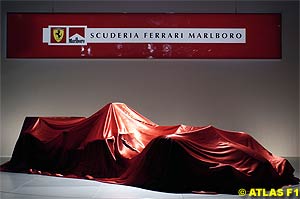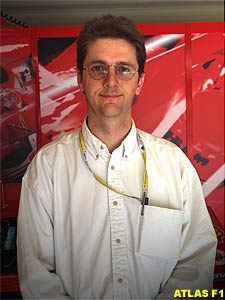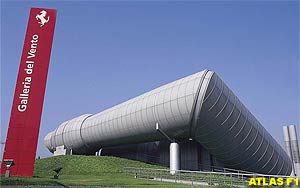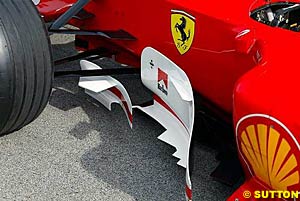
Atlas F1 GP Correspondent
The aerodynamic advantage Ferrari enjoy this year has been obvious to all, and the man most responsible for this is Chief Aerodynamicist John Iley. In his first ever interview, Iley talks exclusively to Atlas F1's Will Gray about his work for the Scuderia, and how he feels when his work 'inspires' the other teams' bodywork
Aerodynamics is a subject that immediately brings a chill to any young engineering student, a complex web of equations and inequalities, a black art, and a mind-numbing conundrum that has become an essential ingredient in the modern age. To succeed on the track, it is vital. And that is why Ferrari spends millions of Euros every year to come up with something new.
Iley, formerly of Jordan and recruited by Ferrari from Renault in November last year, is the man charged with the task of efficiently turning that money spend into performance gain. And eight months after his arrival he has already discovered that the team's professional atmosphere is the most vital internal ingredient of success at Ferrari.
"Ferrari is a remarkably cohesive team," said Iley. "The stability that has been generated here on the technical side is completely understandable and it is one of the strengths of the team that everyone has been here for a long time, working together and keeping the focus and the direction of the team 100 percent in the right place.
"The atmosphere here is excellent and I think that when you get that strength of team and that sort of stability then it makes it very easy for someone to join from the outside. For me, personally, I am very proud to be here and, I have to be honest, I wasn't expecting to be working here during my career."
Once known as the dream quartet, Ferrari's chiefs comprised Brawn, Todt, world champion driver Michael Schumacher and chief designer Rory Byrne. But the Ferrari technical genius list has increased in recent years with engine guru Paolo Martinelli and statistician Luca Baldisserri both being brought out from behind the red curtain and the reclusive Iley is set to be the next man to join that all-important clan.
Like Byrne, Iley rarely appears at races. He turned up in Monaco but rather than being paraded in scarlet he was dressed in civvies to sneak around the paddock and pits snapping shots of rivals' cunning ideas. The bright red Ferrari Olympus camera kind of gave the game away, yet he remained untouched in the milling paddock. Again, he will likely appear in Monza, but the wind tunnel is his home.
There, he helps a huge team hone Ferrari's sleek scarlet machine closer and closer to perfection at an astonishing rate. Bleary-eyed aero engineers work in shifts as the wind tunnel in Maranello whirrs on 24 hours per day, day after day after day, creating, testing, modifying and re-testing relentlessly to ensure, every two weeks or so, German Schumacher and his Brazilian team-mate Rubens Barrichello can continue their pursuit of success.
It is a far cry from some years ago when, fresh out of university, Iley recalls using wind tunnels hired from national defence organisations to improve their cars on the odd occasion, hiring perhaps two or three specialists who would design, build and test the pieces and even drive the van to the wind tunnel. Now Iley has someone to drive his van. And there are plenty of other people to help him get the job done too.
"Aerodynamics has gone through a very huge change in the recent times and it has accelerated massively in the last five years," said Iley. "I started about 14 years ago in Group C - the World Sportscar Championship. I was a one-man aero department, the model we used was only third scale, sometimes I even used quarter-scale models, and we did around seven days of testing a year.
"By comparison, these days most of the top teams' Formula One aero departments are over 60 people and you are running 24-Hours per day, often in more than one wind tunnel. With the size of the department and the logistics of running sometimes in more than one place and overnight you have to be incredibly methodical and structured and planned in your approach.
"The days of developing on the fly in the tunnel are normally long gone now because the quality of the components and rigorousness of the testing means that when you do find something you need to investigate it properly. You do still get some opportunities because unexpected results come up or you have some avenues that you weren't anticipating but generally you take those results on board and do a proper programme to investigate."
Ferrari, Iley revealed, run 24-hours in a single wind tunnel in Maranello, and all that time is spent working to better past efforts, focusing on one thing - improving lap times. The faster the lap time around any circuit, the better the chance of beating the opposition. Pure top-speed is not of interest. It is the speed that a car can go around corners that gives top drivers the edge.
Designers are not aiming to create a sleek machine, they need downforce, downforce and more downforce. But, as with all parts of a Formula One car be it mechanical, electronic or aerodynamic, the art is one of compromise. And the balance between that and drag is one of the most important equations in Formula One. It always has been, and it always will be.
"The path from wind tunnel to car is so direct that aerodynamics is the most logical tool the teams have to improve their car," said Iley from the world champions' hallowed Maranello home. "Aerodynamics is the most direct way to improve the performance of the car and the efficiency of the car is about the efficiency of the department.
"Now, the reality is not anything close to that because you have to support that structure, it is a lot more difficult running at night, there are more people to manage. It is not a linear fit but, unfortunately, for all the hard-working people in aero departments in Formula One there is a trace that says the more hours you work and the more places you work the more development you make and the faster the car goes.
"A typical aerodynamic development rate for a Formula One team would be around one percent per month. Ferrari's development rate is obviously confidential but I think it is fair to say the whole team here has done an excellent job and results are speaking for themselves at the moment." Indeed they are. And so are the designs of the cars from their rivals.
It is no coincidence that the new sidepods on McLaren's MP4-19B are curvy, that the Renault employs an impressively narrow back end or that the new Toyota has become increasingly shapely at the rear. Every team employs at least one man and sometimes a team of 'scouts' to seek out the ultimate designs from their rivals and put them on their own car – even, as Iley proved, Ferrari.
It is not cheating. It's part of the game. In fact, it is rather flattering. Aside from the grid girls, Ferrari's rear end is one of the most curvaceous entities in the Grand Prix circus and Iley admitted: "I think the rear end is something that has been looked at in great detail for the last two years now in Ferrari and it is a trend.
"I think it is always a very promising sign, if you like, that Ferrari has had some very original areas on the car and other teams have adopted some of the principles that were started here. It is nice in some ways, flattering, but also the reverse in that they are adopting some of your solutions so you don't maintain some of the advantage you clearly had.
This cribbing technique is well practiced in all walks of life but it is most noticeable under the eagle eye of Formula One. Take a look at the grid before the next race in Hungary and play spot the technical director. They are all there, openly flaunting their all-access passes with the help of a notepad and pen or simply logging facts in a finely honed brain. Ferrari's regular 'grid spotter' is Brawn, but Iley is the man who tells him if his thoughts are right.
"These days the cars are very highly scrutinised so you are very aware of what people are doing," said Iley. "In the past I have been strongly persuaded to pursue various avenues of development on the car but ultimately it is data-driven. If a particular principle doesn't work on the car that you are developing at any time then the numbers rule. If your car doesn't show the improvement for those devices then you don't do it."
Schumacher and Barrichello both also play a vital part in the continued development of their machines week on week, year on year, with their feedback to the team both on a race weekend and on their crucial visits to the factory, and the wind tunnel facility, in Maranello. And Iley confirmed that Schumacher's dedication and commitment to the team are as strong as ever in that department.
"I have seen Michael quite a few times since I joined and the drivers still have a very important role to play in the car development," he said. "Car telemetry gives you a huge amount of raw data these days and it is an area that is always expanding, getting more and more information from the car. But there are still aspects of the car's performance that rely heavily on driver feel and driver feedback.
"These are the very much more difficult to quantify or measure areas of the car such as stability and confidence that the driver feels and there is definitely lap time to be gained or lost in these areas of the car. Ultimately the driver is the main measurement tool for those areas so you are still very reliant on his feedback and if he is happy with the car then obviously the car will go quicker.
Fitting in is the key to race car design and aerodynamics is such an integral part of the process that the sport's top technical directors, like McLaren's Newey, Geoff Willis of BAR-Honda, Bob Bell of Renault and Mike Gascoyne of Toyota, all have their roots there. It is, of course, logical. Especially so in a modern age where going to the wind tunnel is as hectic as taking part in the race itself.
"To a certain degree there is some logic to it in that," said Iley. "Aero is one of the key performance areas that the teams have control over, so to have the person in charge of the technical side of the car coming from a background in that area is logical. The other factor is that aero departments, with their size these days, are a microcosm of the team itself.
"That they do fundamental lay-out of the car, they do design, research and development, composites, constant testing and data analysis. It is almost like a small Grand Prix team within the team so you have quite a broad understanding of the main aspects of the team because they are involved in the fundamental lay-out of the car, they do design, research and development, composites and constant testing and data analysis.
"It is one of the most performance-driven areas of the team and it is a good training ground. Also, for the department itself, the pressure to deliver and the amount of testing we do means that for us almost every day is like a Grand Prix. The team travel to a race every two weeks but for us we are trying to get the best result we can every day."
Iley's team seems to achieve that aim as well as Ferrari are able to win on any circuit, in any conditions. Schumacher is peaking like we have never seen him peak before and even Brawn has to laugh at the fact they are still up front with their rivals reeling in their wake, the world champions five consecutive times, quite probably six by the end of the Hungarian Grand Prix.
Despite that, complacency is not an issue and Iley insists it will never become one. "It is very important to maintain or even improve the position of Ferrari and we are very conscious that we should not get complacent," said Iley. "But I don't think there is any danger of that within the organisation." And so the drone from Maranello will continue unabated.
It is midnight in Maranello, and there is a gentle drone. The wind tunnel team are working around the clock, once again, to forge ahead in the fight for Formula One glory. There are many crucial parts to the modern Grand Prix machine but there is no denying aerodynamics, the art of creating forces out of nothing, is the door to success. And the men involved are the key to the lock.
 Ferrari's all-conquering scarlet Formula One cars, like all the machines on the Grand Prix grid, derive their form from hours spent chasing numbers in the air and the team's chief aerodynamicist, John Iley, his distinctive round glasses hiding the bags under tired eyes, leads one of Ferrari's most vital departments, a department that continues to spectacularly defy expectations.
Ferrari's all-conquering scarlet Formula One cars, like all the machines on the Grand Prix grid, derive their form from hours spent chasing numbers in the air and the team's chief aerodynamicist, John Iley, his distinctive round glasses hiding the bags under tired eyes, leads one of Ferrari's most vital departments, a department that continues to spectacularly defy expectations.
 Modest and unassuming but clearly one at the top of his field, Iley fits perfectly within Ferrari's incredible team of minds. Initiated by team chief Jean Todt and honed by technical director Ross Brawn the Ferrari engineering team has grown to become Formula One's proof that success breeds success. And as it becomes more and more impressive, the names of the men further behind the scenes filter out.
Modest and unassuming but clearly one at the top of his field, Iley fits perfectly within Ferrari's incredible team of minds. Initiated by team chief Jean Todt and honed by technical director Ross Brawn the Ferrari engineering team has grown to become Formula One's proof that success breeds success. And as it becomes more and more impressive, the names of the men further behind the scenes filter out.
 "I basically designed the parts on a drawing board, as it was then, I would make them doing laminating and pattern making, prepare the model before testing, drive the van to the wind tunnel, carry out the testing in a customer tunnel, as we all had in those days, analyse the results then pass on design information to a full-scale drawing office for actually making parts for the car.
"I basically designed the parts on a drawing board, as it was then, I would make them doing laminating and pattern making, prepare the model before testing, drive the van to the wind tunnel, carry out the testing in a customer tunnel, as we all had in those days, analyse the results then pass on design information to a full-scale drawing office for actually making parts for the car.
 "You see, if you improve the car one percent per month but at that time you are only running 12 hours per day, then you can extrapolate that theoretically and say maybe, if we ran 24-Hours per day maybe we can develop at two percent per month. Then if you say if we run in more than one wind tunnel 24-Hours per day then maybe we can develop at four percent per month.
"You see, if you improve the car one percent per month but at that time you are only running 12 hours per day, then you can extrapolate that theoretically and say maybe, if we ran 24-Hours per day maybe we can develop at two percent per month. Then if you say if we run in more than one wind tunnel 24-Hours per day then maybe we can develop at four percent per month.
 "You are always trying to develop the key areas of the car as quickly as you possibly can but I think you always learn from the previous year and you try and make sure that if there were any aspects of the previous year's car that weren't perfect that on the new car they are corrected and improved. And you also learn from others."
"You are always trying to develop the key areas of the car as quickly as you possibly can but I think you always learn from the previous year and you try and make sure that if there were any aspects of the previous year's car that weren't perfect that on the new car they are corrected and improved. And you also learn from others."
 "But we also give drivers information as to where we are developing the car, what we feel the latest developments will do for them, and also, interestingly, they can give us feedback on where they feel maybe other competitors are strong, or not so strong, in what they are doing. So that gives us a clue as to globally where we fit against the competition."
"But we also give drivers information as to where we are developing the car, what we feel the latest developments will do for them, and also, interestingly, they can give us feedback on where they feel maybe other competitors are strong, or not so strong, in what they are doing. So that gives us a clue as to globally where we fit against the competition."
|
Contact the Author Contact the Editor |
Please Contact Us for permission to republish this or any other material from Atlas F1.
|
Volume 10, Issue 30
Atlas F1 Exclusive
Interview with John Iley
Bjorn Wirdheim: Going Places
Ann Bradshaw: Point of View
2004 German GP Review
2004 German GP Review
Technical Review: Germany 2004
Raising the BAR (Part III)
A Wing and a Prayer
Stats Center
Qualifying Differentials
SuperStats
Charts Center
Columns
The F1 Insider
Season Strokes
On the Road
Elsewhere in Racing
> Homepage |